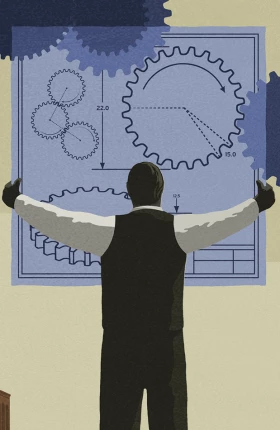So far, many European automotive suppliers have come through the most recent downturn in the continent’s automotive industry relatively unscathed. For some, the downturn may seem like merely a “light breeze,” but the “perfect storm” may be gathering, as more suppliers are feeling the impact of measures that struggling carmakers are taking in response to the crisis. Suppliers are facing greater pricing pressure and declining order volumes in Europe, as well as more intense competition from rivals based in emerging markets. Small and medium-sized suppliers are confronting greater risk of financial distress than large suppliers.
The Gathering Storm in Europe
Unlike the downturn experienced by the automotive industry worldwide from 2008 through 2009, the decline in sales and production from 2011 through 2013 has been concentrated in Europe, where sales are forecast to decrease at an annual rate of more than 6 percent for this period, and production is predicted to fall by more than 4 percent annually.
Elsewhere, the outlook for sales and production has improved substantially. Auto sales in North America and Japan are expected to grow at an annual rate of nearly 10 percent from 2011 through 2013, while production is predicted to increase annually by more than 10 percent in North America and by more than 5 percent in Japan. Carmakers in the BRIC countries of Brazil, Russia, India, and China have been enjoying growth in sales and production of more than 5 percent annually, although growth has recently lost momentum.
The European countries hit hardest by the crisis have been France and Italy. Sales in France are expected to decline by more than 10 percent annually from 2011 through 2013, while production is forecast to decrease by 13 percent annually. In Italy, sales are predicted to drop by more than 15 percent annually for the same time period, and production is anticipated to fall annually by more than 8 percent. In Spain, sales and production (which had been under severe pressure in 2012) showed signs of stabilizing in 2013, as they did in Germany.
European carmakers in the volume segment have been especially hurt by declining sales. Volume players’ European sales (measured in terms of vehicle registrations) in the first half of 2013 were 7 to 12 percent lower than they were in the first half of 2012. This drop followed a slump in the first half of 2012, when sales were off 10 to 19 percent compared with the first half of 2011. (See Exhibit 1.) Sales volume has been relatively stable for premium players, with growth in exports compensating for a slight sales decline in Europe. These different trajectories for volume and premium players have been reflected in the capital markets, where volume players are perceived as having significantly higher levels of credit risk.
Overall, European carmakers are expected to see revenues decline by 10 percent (approximately €35 billion) during the two-year period from 2012 through 2013, while profits are predicted to fall by nearly 40 percent (approximately €14 billion). Cost-improvement programs are expected to offset 60 to 70 percent of the profit loss (approximately €8 billion to €10 billion). Effective improvement programs have already helped premium players maintain a stable performance despite the headwinds in European markets. Volume players are likely to further intensify their efforts to achieve savings by streamlining factory operations, optimizing capacity utilization, reducing capital expenditures, and realizing synergies in sourcing, development, and production.
Although these cost improvements are good news for carmakers’ bottom lines, the programs are translating into severe margin pressure for suppliers. Typically, 55 to 65 percent of the savings car manufacturers achieve come from extracting lower prices from their suppliers. This means that European suppliers could be facing a margin decline of €5 billion to €6 billion from price reductions.
Declining order volumes from carmakers are another concern for suppliers. Orders are predicted to decrease by €17 billion, which could translate into an additional profit loss of €6 billion to €7 billion. Given greater pricing pressure and lower volumes, European suppliers risk a total profit loss of €11 billion to €13 billion in 2013, compared with profits earned in 2011.
In addition to these short-term pressures, European automotive suppliers are facing the threat of competition from suppliers in emerging markets. These challengers are benefiting from the strong growth of the automotive market in Asia and from the increased demand created by European carmakers that have built capacity overseas. Struggling European suppliers have already become acquisition targets for players from emerging markets, as illustrated by the purchase of the German-based Neumayer Tekfor Group by India’s Amtek Auto.
Assessing the Risk Factors for Suppliers
Given the state of the European automotive industry, which factors determine suppliers’ risk of financial distress?
To evaluate this, we designed a “risk compass” that combines industry and financial risk indicators to assess the level of risk faced by suppliers. Industry risk indicators include size (in terms of revenue), the manufacturing footprint by region, product offering, and customer portfolio. Key financial-risk indicators include sales growth, earnings before interest and taxes, and return on capital employed.
Our analysis identified four factors that indicate high risk exposure for a European supplier:
- A narrow regional focus for sales. Risk exposure is especially high if more than 90 percent of a supplier’s sales are in Europe.
- A high dependency on the automotive industry. Risk exposure is also especially high if more than 90 percent of a supplier’s sales are to automotive companies.
- Being a small or medium-sized supplier. Small and medium-sized suppliers with sales of less than €500 million are typically less diversified than larger suppliers in terms of their manufacturing footprint by region and product offering.
- Being a tier one supplier. Among small and medium-sized businesses, tier one suppliers face higher risk, because they are directly exposed to pricing pressure from carmakers.
These risk factors identified by the risk compass were also common among European suppliers that have been experiencing insolvency in recent months.
To further analyze risk factors and their evolution over time, we segmented a sample of European suppliers based on their size and regional diversification and found the following:
- Small and medium-sized suppliers with a narrow product portfolio and no subsidiaries outside Europe have already felt the impact of the recent crisis, especially those most dependent on sales to volume carmakers. These suppliers have experienced the most significant declines in sales and margins compared with their more diversified competitors. Small and medium-sized suppliers are especially exposed to the crisis going forward, because they are highly dependent on European markets and typically have limited resources for diversification or internationalization.
- Small and medium-sized suppliers with one subsidiary outside Europe have been substantially less affected by the recent crisis than their counterparts with none. In addition, these suppliers’ sales and margins, which suffered as a result of the downturn from 2008 through 2009, are on track for a solid recovery. Because these suppliers have operations outside Europe, they are somewhat less dependent on European markets and consequently less exposed to the crisis going forward than Europe-focused suppliers.
- Large international suppliers with subsidiaries in more than two non-European regions and with sales greater than €1 billion have seen the strongest recovery from the previous crisis. The regional and customer diversification of these suppliers allowed for a strong growth trajectory after 2009 and helped them return to precrisis margin levels. As a result, they generally should be able to cope well with the current European crisis. However, they must contend with increasing competition from suppliers in emerging markets.
It is important to note that suppliers not facing the four risk factors could still be in acute distress. Conversely, some suppliers that display certain high-risk characteristics may not face immediate risks. For a supplier to understand its level of risk, it must conduct a company-specific assessment.
At the company level, “risk scenario planning” can provide a market-based validation of sales expectations and financial implications.
Validating sales expectations is critical, because the failure of order volume to meet a supplier’s expectations is the main driver of financial distress. The assessment of future sales volume projects how the previous year’s sales volume will change owing to the negative impact of carmakers ending the production of certain models and the positive impact of carmakers launching new models. Additionally, the market effects resulting from changes in the sales volumes of models produced in the previous and current years are gleaned from external sources (such as IHS) and factored in. Finally, the analysis applies a forward-looking assessment to adjust for downside risks. The output is a risk-informed range for expected sales.
Risk scenario planning also entails a simulation of financial outcomes for the company should the downside risks occur. The output of the simulation includes the impact on contribution margin and earnings; an assessment of potential countermeasures; and the sustainability of available financing schemes (such as liquidity requirements and covenants). The output enables the company and its stakeholders to assess the requirements for contingency planning and immediate action.
Restructure and Grow—at the Same Time
To develop a response to risks, automotive suppliers need to consider the distinctive dynamics of today’s European-focused crisis. Responses to the previous crisis typically followed a sequential approach: the restructuring of operations to reduce costs was the first priority, and growth programs were initiated only after the global economy began to recover.
In today’s environment, however, suppliers cannot delay their pursuit of growth. Because the crisis is largely restricted to Europe, suppliers have to pursue growth opportunities in North America and emerging markets at the same time they seek to improve the efficiency of their European operations. Indeed, initiatives to expand in other regions will be essential to stemming the tide of competition from suppliers in markets enjoying higher growth rates.
The sequential and simultaneous approaches to restructuring and growth are fundamentally different. (See Exhibit 2.) The sequential approach leads to a V curve, because profitability continues to decline until the restructuring programs achieve results, while growth programs only begin thereafter. In contrast, the simultaneous approach leads to an X curve, because suppliers restructure their European operations at the same time they execute growth programs in North America, Asia, or other emerging regions—allowing for profitability to return sooner.
The operational-improvement levers applied in the restructuring effort should address liquidity, costs, and the structure of assets and the organization. Growth initiatives should be targeted at optimizing the company’s product and customer portfolios and regional footprint. Suppliers can use risk scenario planning as an entry point for a diagnostic of their starting position and to prioritize improvement levers.
As the challenges confronting European automotive suppliers intensify, a strategic approach to risk assessment, restructuring, and growth will be essential. A supplier and its stakeholders will need to understand the company’s vulnerabilities as European carmakers in both the premium and volume segments take aggressive steps to shore up their own positions in the face of persistent headwinds. The threat of competition from challengers in emerging markets must also be thoroughly assessed. With this fact base in hand, a supplier can turn to defining a tailored strategy for restructuring its operations while simultaneously pursuing carefully selected growth opportunities in international markets.








